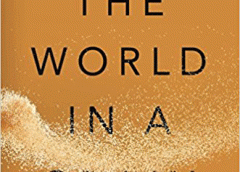In advance of a new book getting ready to hit the market, “The World in a Grain: The Story of Sand and How It Transformed Civilization,” the L.A. Times allowed its author, Vince Beiser, to write an opinion piece.
The opinion piece did not sit well with many industry professionals.
“The author alleges that our country is running out of sand, which is false,” said Michael W. Johnson, IOM, president and CEO of the National Stone, Sand and Gravel Association. “However, there are incredibly long delays for new quarries to get approval to produce the sand and other aggregates we need for current and future infrastructure projects. Most aggregates, like sand and crushed stone, are used with 50 miles of where they were produced because rocks are heavy. It takes significant resources to transport aggregates over far distances. When costs for materials rise, when needless litigation and over-regulation cause delays, the burden is ultimately born by the taxpayers that have to pay more to fix aging roads, bridges and highways. Our infrastructure needs, and the lack of federal support, are worrisome, not the availability of sand.”
“Societal development requires solutions that last for generations, endure harsh environmental and physical challenges, require less maintenance and replacement materials/activity and reduce additional environmental costs during the use or occupancy phase, salvage and disposal,” said William Larson, vice president marketing, CalPortland, Glendora, Calif. “Concrete has provided those returns consistently as history illustrates since the ancient civilizations of the Romans and Greeks. By reducing the need to rebuild, maintain and reclaim, concrete can provide protection beyond current building code and provide the resilience for structures to perform beyond design demand and recover quicker after climatic or physical calamity.
“Research indicates that; rigid concrete pavements dramatically reduce fuel consumption which in turn reduces GHG emissions, provides thermal value when used in buildings regarding heat and cooling requirements reducing energy consumption and additional GHG production. Contrary to the author’s claim, Urban Heat Island is mitigated, further reducing GHG production,” Larson said.
“We are members of the Build with Strength Los Angeles Coalition, and together we represent diverse communities united in the effort to advocate for the use of safe, non-combustible, and sustainable building materials,” said Kathleen Carr-Smith, executive vice president communications, concrete promotion, National Ready Mixed Concrete Association. “We were disappointed with the inaccuracies in Vince Beiser’s L.A. Times article regarding concrete’s place in modern construction. Amidst our ever-increasing population density, it is non-combustible construction that keeps us safe in our homes, work places, schools and places of worship. While infrastructure upgrades are always welcome, the assertion that a non-combustible construction material be replaced leaves us vulnerable to development with cheaper materials that put lives in danger, like wood.
“The author links concrete to global carbon emissions, but only tells half the story by omitting that the sustainable and insulating nature of concrete contribute the lower lifetime energy usage and costs to heat and cool these structure, not mention the implied alternative of clear-cutting for building materials threatens the ability of forests to remove carbon from the air; and the devastating impact of a fire on structures built with combustible materials can bring a community to its knees,” Carr-Smith said.
The book is due to be released August 7.

